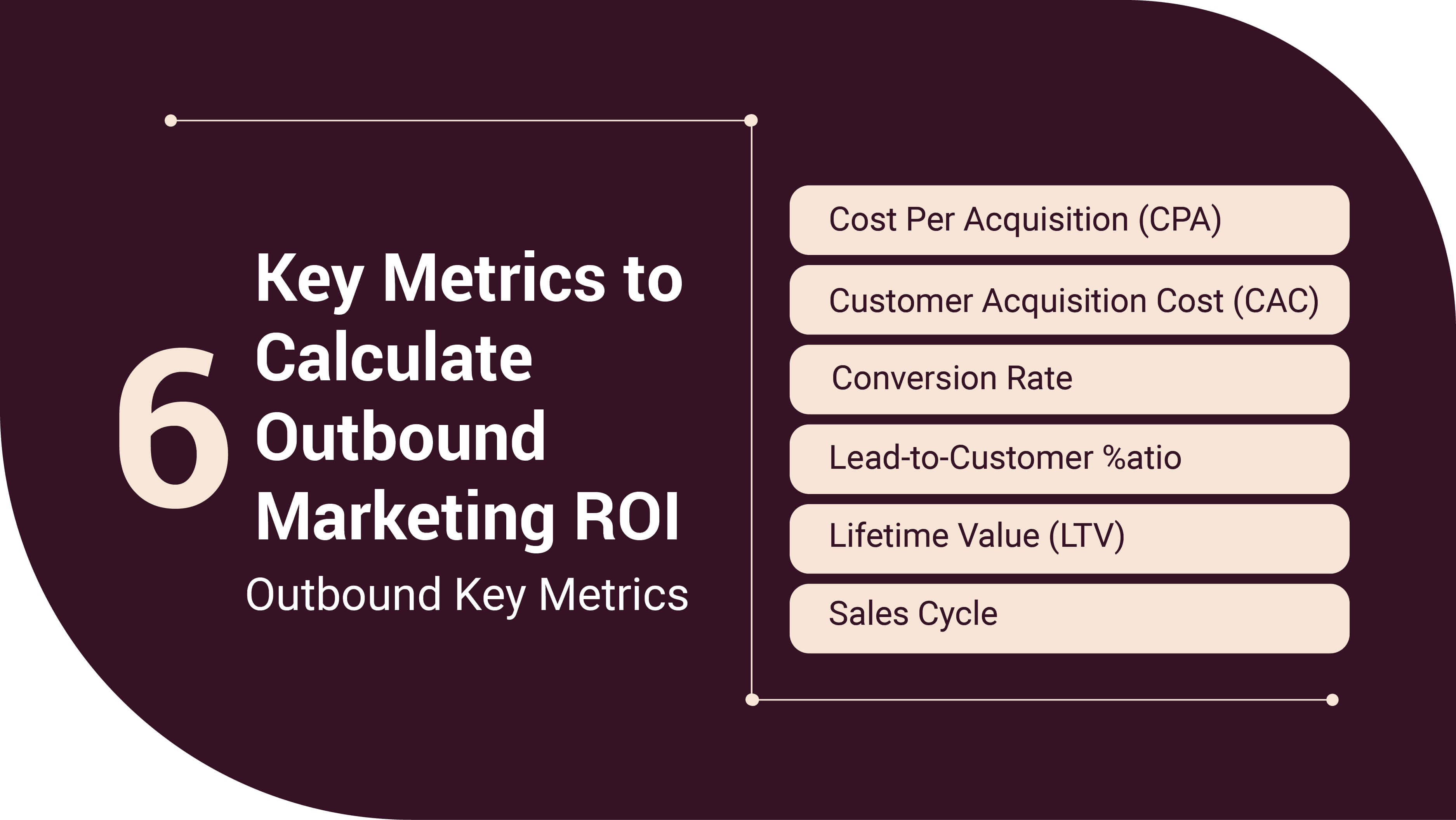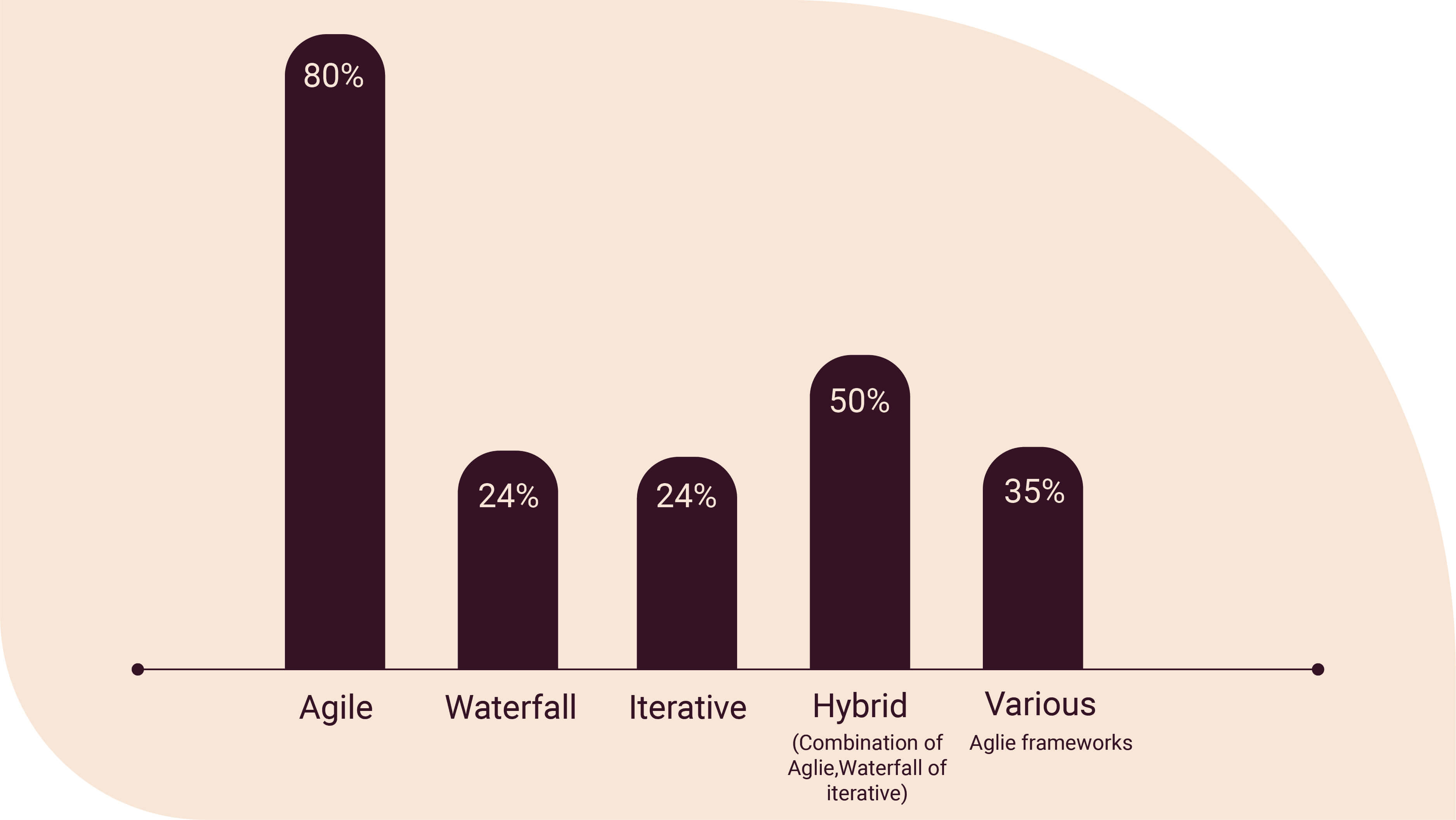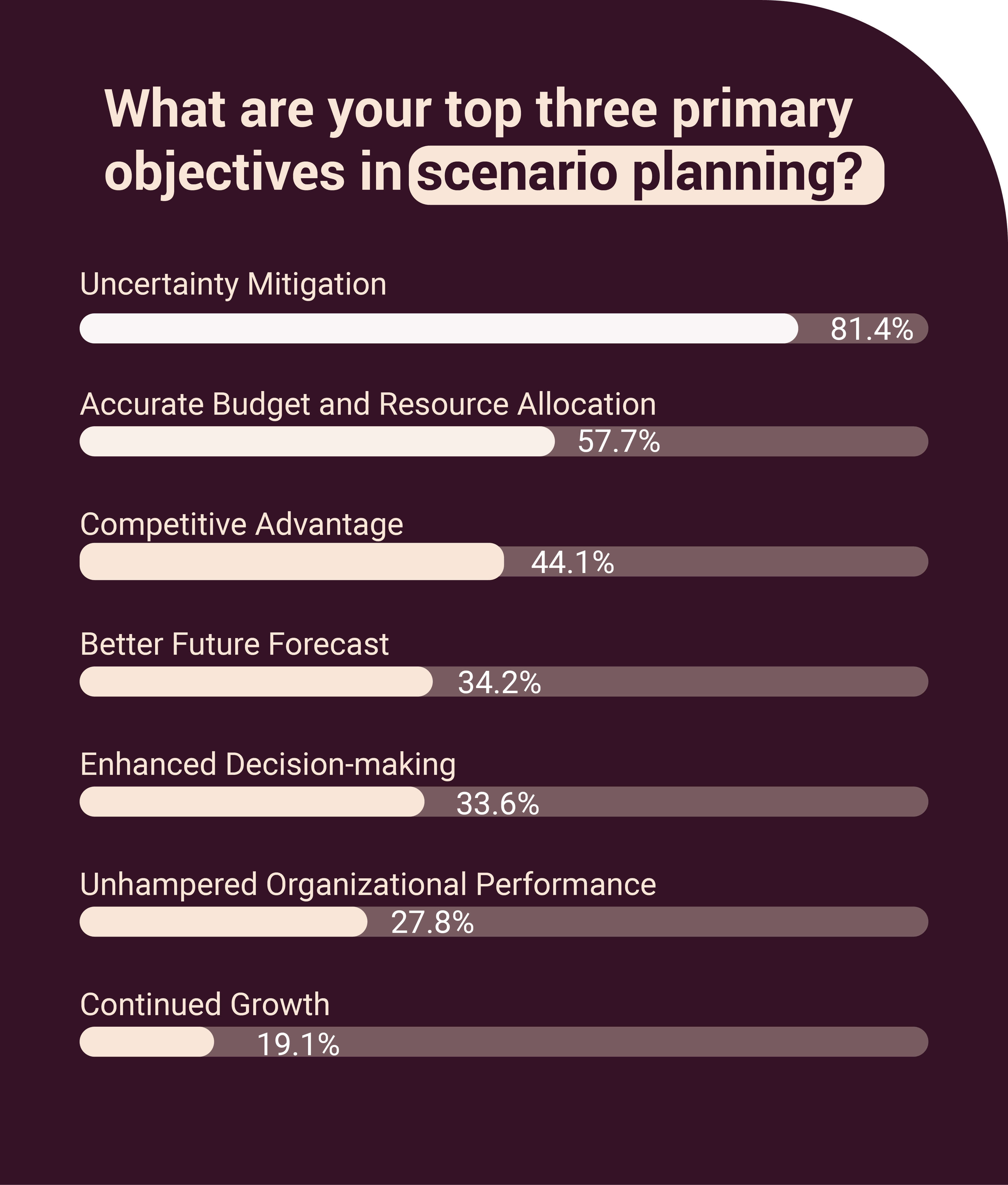
How to Boost Outbound Marketing ROI: 10 Best Practices
Recent studies reveal a no-brainer: businesses that calculate ROI are 1.6 times more likely to exceed their growth goals.
Now, in outbound marketing, ROI is even more critical. Why? Because a quantified value of your outcomes gives you an accurate picture of your efforts’ efficiency.
In this article, we'll break down the essentials, showing you how to calculate outbound marketing ROI. We’ll also explain the metrics and strategies to measure the same.
Ready to cut through the jargon and make your B2B marketing game count? Let's dive in.
Outbound Marketing ROI: The 6 Key Metrics

To effectively measure your outbound marketing ROI, you must grasp these six key metrics and their formulas. Here's a breakdown:
- Cost Per Acquisition (CPA): Average cost to acquire a customer or lead in a specific outbound campaign.
Formula: CPA = Total Cost of Campaign / Number of Conversions or Acquisitions.
- Customer Acquisition Cost (CAC): Comprehensive cost of acquiring a customer, considering overall expenses.
Formula: CAC = Total Cost of Acquisition / Number of Customers Acquired.
- Conversion Rate: Percentage of prospects converted into customers, indicating campaign effectiveness.
Formula: Conversion Rate = (Number of Conversions / Number of Leads) * 100.
- Lead-to-Customer Ratio: Efficiency of lead conversion, reflecting sales team performance.
Formula: Lead-to-Customer Ratio = Number of Customers Acquired / Number of Leads. - Lifetime Value (LTV): Total revenue expected from a customer over their relationship with the company.
Formula: LTV = Average Purchase Value * Purchase Frequency * Customer Lifespan. - Sales Cycle: The time taken from initial contact to closing a deal. This metric is crucial for understanding the overall efficiency of your sales process.
Now, we've laid the groundwork with essential metrics and formulas. Next, let's delve into actionable strategies to elevate your outbound marketing ROI.
10 Best Practices for Boosting Outbound Marketing ROI in 2024
These ten strategies will equip you with the tools needed to navigate the dynamic marketing landscape. Plus, they will ensure your outbound efforts translate into measurable success.
1. Implement Tracking Systems
To enhance outbound marketing ROI, you MUST focus on precision in monitoring your campaign’s touchpoints. As such, implement advanced tracking tools to achieve this goal.
- Utilize UTM (Urchin Tracking Module) parameters to track digital channel performance comprehensively. They provide granular insights into user interactions.
- For offline campaigns, employ unique phone numbers and promo codes. These tools enable precise attribution and measurement.
2. Leverage Analytics Platforms
To amplify your outbound marketing ROI, leverage robust analytics platforms:
- Utilize tools like Google Analytics for comprehensive performance analysis. It gives deep insights into user behavior and campaign effectiveness.
- Integrate CRM (Customer Relationship Management) data to align your marketing efforts seamlessly with sales outcomes. It helps foster a unified approach across the customer journey.
- Explore AI-driven analytics, leveraging predictive capabilities to identify trends and anticipate market shifts.
By harnessing the power of analytics platforms, you can:
- Refine your strategies
- Optimize resource allocation
– ultimately enhancing the effectiveness of your outbound marketing campaigns.
3. Revise Time-tested ROI-calculation Formulas
To navigate economic fluctuations, refine ROI calculation formulas to create a resilient marketing strategy. Consider these strategic adjustments:
-
Adapt ROI Formulas
-
- Original Formula: ROI= (Net Profit/ Cost of Investment) x 100
-
- New Formula: ROI= [(Net Profit − Economic Downturn Cost)/ (Cost of Investment+Economic Downturn Cost)] x 100
Explanation: This modification incorporates the impact of economic downturns. It involves subtracting additional costs incurred during challenging times and adjusting the denominator accordingly.
-
Adjust Benchmarks During Recovery
-
- Original Focus: Considered historical benchmarks for performance.
- Strategic Adaptation: Acknowledges recovery phases by recalibrating benchmarks – based on evolving market conditions and economic recovery indicators.
-
Incorporate Risk Mitigation Strategies
-
- Original Approach: Calculated standard risk assessment within the business framework.
- Strategic Addition: Actively includes risk mitigation strategies tailored to uncertain economic times, ensuring ROI safeguarding.
Next, let’s check out how to incorporate the above adjustments through an example:
In a B2B marketing campaign, you apply the original ROI formula – when the net profit is $30,000 and the investment cost is $10,000. Your ROI is 200%.
However, let’s say an economic downturn incurs an additional $5,000 in costs. Then, the adapted formula considers these circumstances, yielding a revised ROI of 150%.
4. Align Metrics with Business Objectives
To supercharge your marketing strategies, you need to align metrics with your business objectives for insights that truly matter. Here's how:
-
Set Clear Business Objectives
-
- Define specific and measurable goals that directly tie into overall business priorities.
- Example: Aim to boost lead generation by 20% in the next quarter.
-
Map Metrics to Customer Journey Stages
- Tailor metrics to match different phases of the customer journey for a complete view.
- Example: Use lead conversion rates for the 'Consideration' stage and CAC for the 'Decision' stage.
-
Ensure Alignment with Overall Business Goals
- Confirm that chosen metrics directly contribute to broader business objectives.
- Example: If the goal is revenue growth, focus on metrics like LTV and conversion rates.
5. Integrate Multichannel Attribution Models
By implementing attribution models, you can analyze the customer journey holistically, assigning appropriate credit to each touchpoint. It ensures a nuanced assessment of marketing efforts.
Hence, it acknowledges the collaborative influence of multiple channels in driving conversions and ultimately, ROI.
Let's consider an example of a standard attribution model: the Time Decay Model. Here, touchpoints closer to the conversion receive more credit than those further back in the customer journey.
| Touchpoint | Attribution Weight |
| Phone Call | 35% |
| LinkedIn InMail | 30% |
| Email Marketing | 20% |
| Direct Website Visit | 15% |
In times of economic recovery, adjust attribution models by adapting to the specific shifts in consumer behavior. It enables you to refine your marketing strategies based on channel contributions. As such, it fosters optimized decision-making and heightened campaign effectiveness – leading to improved ROI.
6. Prioritize Dynamic Budget Allocation
Businesses achieving agility in budget allocation boast an impressive 80th percentile success rate – outperforming other models.

Hence, you ought to prioritize dynamic budget allocation for excellent ROI. How?
- Regularly assess and fine-tune your budget based on channel performance. It lets you strategically direct resources to resilient and effective avenues.
- Embrace agile budgeting. It helps ensure swift responses to shifts in consumer behavior and market trends.
- Link your budget directly to channel performance for optimized spend. It helps you position yourself at the forefront of the dynamic landscape.
7. Collect Customer Feedback
Customer-centric companies are 60% more profitable than companies that aren't. And here, feedback plays a critical role in elevating the consumer experience. Therefore, integrate feedback mechanisms in your strategy to grasp buyer sentiment.
Leverage sentiment analysis tools – like MonkeyLearn, Brandwatch, and Lexalytics – to gauge the impact of marketing campaigns on customer perception.
Ensure your strategies remain agile by adjusting your approach based on valuable customer feedback. It’s a proven pathway to enhance ROI and cultivate lasting customer relationships.
Let's say you launch a new product. Social media reviews indicate customers are dissatisfied with the product's user interface. To adjust your strategy:
- Acknowledge the feedback promptly. Speed is crucial to address concerns before they escalate.
- Use the feedback to identify specific pain points in the user interface. Work on quick updates.
- Communicate the changes transparently with your audience. Let them know that their feedback has been heard, and improvements have been implemented.
- Adopt an iterative approach:
-
- Continue monitoring sentiment
-
- Gather ongoing feedback
-
- Make further refinements
8. Apply A/B Testing and Data-based Optimization
Continuously refine your marketing strategies by implementing A/B testing. This iterative approach allows you to test different elements and tactics – to uncover what resonates best with your audience.
Also, leverage real-time data and performance insights to optimize your campaigns. Swift adjustments based on live data ensure your strategies remain dynamic and responsive to evolving market conditions.
Finally, foster a culture of experimentation within your team. Consistently try new ideas and approaches. As such, you can identify and scale the most successful strategies – boosting your ROI.
9. Embrace Cross-Functional Collaboration
Break down silos and foster collaboration between marketing, sales, and finance teams. Each department brings a unique perspective that, when combined, leads to a more holistic understanding of ROI.
Actively share insights and data across departments. This alignment ensures efforts and objectives are in sync. Thus, it promotes a unified approach toward achieving overarching business goals.
Harness the collective expertise of different teams to enhance the accuracy of ROI calculations. By tapping into varied perspectives, you can uncover nuances and refine strategies for more precise assessments.
10. Leverage Scenario Planning
A compelling statistic underscores the significance of scenario planning: 'Uncertainty mitigation' is the primary objective for 81.4% of organizations.”

Hence, proactively devise contingency plans and strategies tailored to various economic scenarios. By prioritizing uncertainty mitigation, your business is well-positioned to navigate challenges and seize opportunities.
Next, actively engage in scenario planning exercises to anticipate potential challenges and opportunities. This structured preparation allows for swift and informed decision-making.
Finally, stay agile by adjusting marketing strategies based on real-time economic indicators and market conditions. This adaptability is rooted in the imperative of uncertainty mitigation. It ensures your marketing efforts align with the changing economic landscape, enhancing overall ROI.
Conclusion
As you can see, to boost your outbound marketing ROI, you need to strategically merge analytics, adaptability, and collaboration. By implementing the ten killer strategies outlined in this guide, you're poised to elevate your ROI – even in an economically uncertain market.
For those seeking more personalized insights and expert guidance, our team at Revnew is here to help. With a wealth of experience and a commitment to your success, we'll work alongside you to tailor strategies that resonate with your business objectives.
Contact our experts at Revnew today: Your journey to optimizing outbound marketing ROI begins here.




